Three Considerations for Stashing Cash After Bank Failures
People are understandably nervous about the safety of their cash accounts. The three-bucket method helps you divide your funds based on when you’ll need to access them.


Ever since the early-March failures of Silicon Valley Bank and Signature Bank, as well as the liquidation of Silvergate Bank and the more recent failure of First Republic Bank on May 1, clients have been asking what they should do with their cash. They want it to have the liquidity they need without being unprotected should the institutions they have it in become unstable. Everyone’s financial situation is unique, but there are some general guiding principles to consider when thinking about the best places to put your shorter-term money.
A common approach to investing is the three-bucket method, where you divide your investments into categories based on when you’ll need to access the money. Money you’ll need in the short term goes into investments that are safe and liquid. Money you will need to access within the next few years can take on a little more risk and be slightly less liquid. Money you won’t need for many years can be invested in higher-risk assets because it will have more time to recover should those assets drop in value. Let’s explore these three categories.
1. Immediate funds
For liquidity-forward investments, I often steer my clients toward a different three-bucket approach in which the time scale is significantly compressed. Under this concept, the first category is for cash you need right away.

Sign up for Kiplinger’s Free E-Newsletters
Profit and prosper with the best of expert advice on investing, taxes, retirement, personal finance and more - straight to your e-mail.
Profit and prosper with the best of expert advice - straight to your e-mail.
You need immediate funds for everything from grocery shopping to dining and entertainment. The box office generally won’t accept CDs as payment for concert tickets! For the majority of people, it’s perfectly safe to keep your immediate-access money in a checking account.
As long as your bank or credit union is insured by the FDIC or NCUA, up to $250,000 of your money is safe in a single checking account. Even if the bank collapses and is completely drained of its assets, you can rest easy knowing you will be reimbursed for any money the bank can’t remit. However, as we saw in the bank collapses, many depositors had far more than $250,000 in their accounts.
Had the government not stepped in and created a special program to guarantee deposits beyond FDIC limits, those depositors would have stood a real chance of losing some, or even most, of their holdings. To protect their money, these high-value depositors could have spread that cash out amongst multiple banks, with each account enjoying its own $250,000 guarantee from the FDIC.
These depositors could have benefited from the lesson of past banking collapses. People who lived through the Great Depression frequently spent the rest of their lives in fear that it would happen again. Many never trusted banks again, instead withdrawing their cash and keeping it close to home. Even today, homeowners still occasionally find Depression-era cash hoards hidden in walls or buried in their yards.
In more recent years, however, the general consumer zeitgeist has been that banking failures won’t ever happen again. Banks are too big to fail, and banking collapses were a relic from a century ago, with modern safeguards rendering them impossible. As we’ve seen recently, that’s clearly not the case!
That makes taking advantage of free insurance for your deposited money a very wise financial decision. There are even systems in place to make it quite easy to distribute your money amongst enough accounts to insure the entire amount in a practice called tranching.
Rather than manually opening an account at every bank to which you’ll distribute money, you can simply use one of the tranching services to do it automatically. Even if you have $50 million to deposit, you can be fully covered by the FDIC with a single account interaction. The FDIC is currently undertaking a comprehensive review of its program; there’s a chance the amount insured per account will increase. For peace of mind, however, it makes sense to use one of these systems rather than waiting for policy to catch up to modern needs.
2. Short-term with growth
The second category to consider is for money you still need in the short term, but which you’d like to grow more than is typically possible in a checking or savings account. Money markets are a common product that fits this bucket, but the question then becomes, how can you be sure your money will be as safe as possible in a given money market fund?
As I tell my clients, this is when you need to look under the hood! Find out as much as you can about the money market fund. What does it own? What percentage of its assets are secure investments, such as ones backed by the Federal Reserve? Consider the fund’s total volume; how much money is invested? The more money the fund has, the less likely it will fall due to a run of depositors simultaneously withdrawing their money. For instance, if a given mutual fund maintains 10% of its deposits in fully liquid cash, that’s a lot more significant if the fund has $190 billion in assets than if it has only $100 million.
It’s also important to investigate the duration of Treasuries owned by the fund. Are they buying longer-duration bonds? If there’s a big run on the fund where many investors want redemptions at the same time, are they in danger of suffering the same setbacks as Silicon Valley Bank?
Remember that a money market fund run by a bank does not necessarily have the same risk profile as the bank itself. A fund could be run by one of the largest and most stable banks in the world, but if the fund itself lacks sufficient structured liquidity, it could still be a risky choice.
3. Longer-duration safety
The third bucket is for money you won’t need for three to six months. For this category, a solid option is U.S. Treasury bonds. You’re guaranteed not to lose your principal because they’re backed by the government, and interest rates on bonds are better today than they’ve been in many years.
With the Federal Reserve vowing to continue raising interest rates until inflation is curtailed, there’s a strong possibility that bond rates will increase further in the coming months, which is why short-term bonds are a compelling choice. You can redeem them in three to six months and evaluate the market then to determine if it’s better to buy more short-term bonds or transition to longer-duration ones.
Because we are experiencing an inverted yield curve, the usual disadvantages of short-term bonds aren’t currently a factor. Building a bond ladder allows you to have regular cash flow from maturing bonds to reinvest in more attractive bonds as interest rates climb.
Early 2023 may very well have marked the beginning of a paradigm shift in cash management. The forgotten lessons of the Depression-era bank collapses were quickly remembered when three banks fell in just a week. While this frightened people, it also served as a valuable reminder that there’s no need to have deposited cash exposed to the risk of loss.
By properly structuring your deposits, you can have your short-term cash fully insured by FDIC or NCUA while enjoying higher interest rates in “safer” investments than have been available for over a decade.
I’ve spent a lot of time since the bank collapses helping clients manage their liquid assets. If you have questions or concerns about the safety of your liquid accounts or how best to structure them, it’s a very good idea to work with a financial professional.
Get Kiplinger Today newsletter — free
Profit and prosper with the best of Kiplinger's advice on investing, taxes, retirement, personal finance and much more. Delivered daily. Enter your email in the box and click Sign Me Up.

As Principal and Director of Financial Planning, Sam Gaeta helps clients identify financial goals and make plan recommendations using the five domains of financial planning — Cash Flow, Investments, Insurance, Taxes and Estate Planning. He is responsible for prioritizing clients' financial objectives and effectively implementing their investment plans and actively monitors the ever-changing nature of clients' financial and investment plans.
-
 The AI Doctor Coming to Read Your Test Results
The AI Doctor Coming to Read Your Test ResultsThe Kiplinger Letter There’s big opportunity for AI tools that analyze CAT scans, MRIs and other medical images. But there are also big challenges that human clinicians and tech companies will have to overcome.
By John Miley Published
-
 The Best Places for LGBTQ People to Retire Abroad
The Best Places for LGBTQ People to Retire AbroadLGBTQ people can safely retire abroad, but they must know a country’s laws and level of support — going beyond the usual retirement considerations.
By Drew Limsky Published
-
 Financial Planning's Paradox: Balancing Riches and True Wealth
Financial Planning's Paradox: Balancing Riches and True WealthWhile enough money is important for financial security, it does not guarantee fulfillment. How can retirees and financial advisers keep their eye on the ball?
By Richard P. Himmer, PhD Published
-
 A Confident Retirement Starts With These Four Strategies
A Confident Retirement Starts With These Four StrategiesWork your way around income gaps, tax gaffes and Social Security insecurity with some thoughtful planning and analysis.
By Nick Bare, CFP® Published
-
 Should You Still Wait Until 70 to Claim Social Security?
Should You Still Wait Until 70 to Claim Social Security?Delaying Social Security until age 70 will increase your benefits. But with shortages ahead, and talk of cuts, is there a case for claiming sooner?
By Evan T. Beach, CFP®, AWMA® Published
-
 Retirement Planning for Couples: How to Plan to Be So Happy Together
Retirement Planning for Couples: How to Plan to Be So Happy TogetherPlanning for retirement as a couple is a team sport that takes open communication, thoughtful planning and a solid financial strategy.
By Andrew Rosen, CFP®, CEP Published
-
 Market Turmoil: What History Tells Us About Current Volatility
Market Turmoil: What History Tells Us About Current VolatilityThis up-and-down uncertainty is nerve-racking, but a look back at previous downturns shows that the markets are resilient. Here's how to ride out the turmoil.
By Michael Aloi, CFP® Published
-
 Home Insurance: How to Cut Costs Without Losing Coverage
Home Insurance: How to Cut Costs Without Losing CoverageNatural disasters are causing home insurance premiums to soar, but don't risk dropping your coverage completely when there are ways to keep costs down.
By Jared Elson, Investment Adviser Published
-
 Markets Roller Coaster: Resist the Urge to Make Big Changes
Markets Roller Coaster: Resist the Urge to Make Big ChangesYou could do more harm than good if you react emotionally to volatility. Instead, consider tax-loss harvesting, Roth conversions and how to plan for next time.
By Frank J. Legan Published
-
 Why Homeowners Insurance Has Gotten So Very Expensive
Why Homeowners Insurance Has Gotten So Very ExpensiveThe home insurance industry is seeing more frequent and bigger claims because of weather, wildfires and other natural disasters.
By Karl Susman, CPCU, LUTCF, CIC, CSFP, CFS, CPIA, AAI-M, PLCS Published